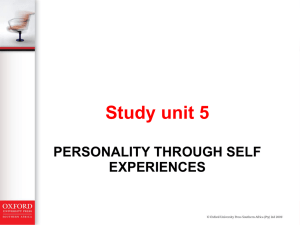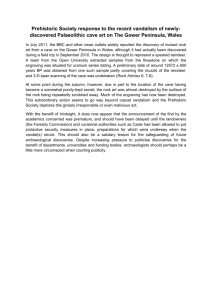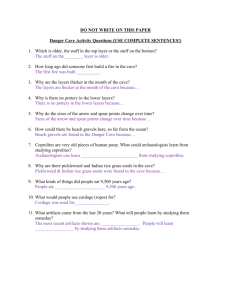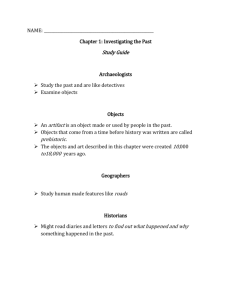The Phenomenological Epoché
advertisement
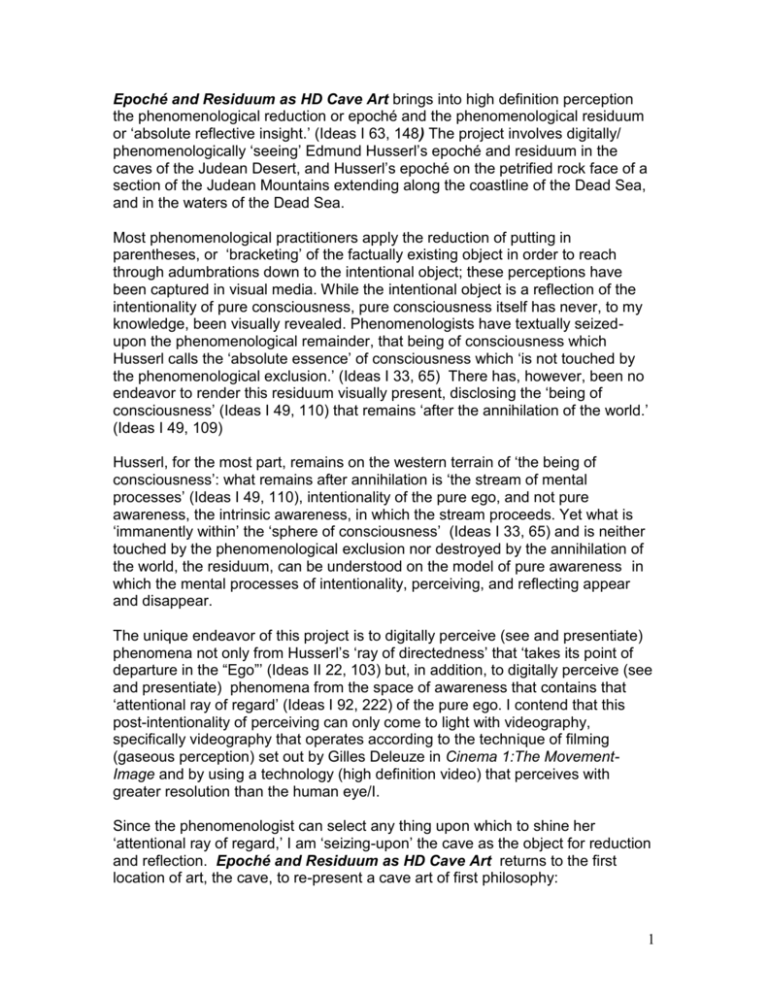
Epoché and Residuum as HD Cave Art brings into high definition perception the phenomenological reduction or epoché and the phenomenological residuum or ‘absolute reflective insight.’ (Ideas I 63, 148) The project involves digitally/ phenomenologically ‘seeing’ Edmund Husserl’s epoché and residuum in the caves of the Judean Desert, and Husserl’s epoché on the petrified rock face of a section of the Judean Mountains extending along the coastline of the Dead Sea, and in the waters of the Dead Sea. Most phenomenological practitioners apply the reduction of putting in parentheses, or ‘bracketing’ of the factually existing object in order to reach through adumbrations down to the intentional object; these perceptions have been captured in visual media. While the intentional object is a reflection of the intentionality of pure consciousness, pure consciousness itself has never, to my knowledge, been visually revealed. Phenomenologists have textually seizedupon the phenomenological remainder, that being of consciousness which Husserl calls the ‘absolute essence’ of consciousness which ‘is not touched by the phenomenological exclusion.’ (Ideas I 33, 65) There has, however, been no endeavor to render this residuum visually present, disclosing the ‘being of consciousness’ (Ideas I 49, 110) that remains ‘after the annihilation of the world.’ (Ideas I 49, 109) Husserl, for the most part, remains on the western terrain of ‘the being of consciousness’: what remains after annihilation is ‘the stream of mental processes’ (Ideas I 49, 110), intentionality of the pure ego, and not pure awareness, the intrinsic awareness, in which the stream proceeds. Yet what is ‘immanently within’ the ‘sphere of consciousness’ (Ideas I 33, 65) and is neither touched by the phenomenological exclusion nor destroyed by the annihilation of the world, the residuum, can be understood on the model of pure awareness in which the mental processes of intentionality, perceiving, and reflecting appear and disappear. The unique endeavor of this project is to digitally perceive (see and presentiate) phenomena not only from Husserl’s ‘ray of directedness’ that ‘takes its point of departure in the “Ego”’ (Ideas II 22, 103) but, in addition, to digitally perceive (see and presentiate) phenomena from the space of awareness that contains that ‘attentional ray of regard’ (Ideas I 92, 222) of the pure ego. I contend that this post-intentionality of perceiving can only come to light with videography, specifically videography that operates according to the technique of filming (gaseous perception) set out by Gilles Deleuze in Cinema 1:The MovementImage and by using a technology (high definition video) that perceives with greater resolution than the human eye/I. Since the phenomenologist can select any thing upon which to shine her ‘attentional ray of regard,’ I am ‘seizing-upon’ the cave as the object for reduction and reflection. Epoché and Residuum as HD Cave Art returns to the first location of art, the cave, to re-present a cave art of first philosophy: 1 phenomenology, by virtue of its essence, must claim to be “first” philosophy and to offer the means for carrying out every possible critique of reason: … it demands the most perfect freedom from presuppositions and … [it demands] an absolute reflective insight. (Ideas I 63, 148) The cave, of course, has philosophical significance for Plato. In the allegory of the cave (The Republic, Book VII) the prisoners see only distorted reflective illusionary shadows of the real (the idea or the forms). The idea, forms, dialectics, reason constitute ‘the doctrinal content’ of what Husserl is bracketing and putting into question in previous philosophical theories. (Ideas I, 18, 34) The philosopher returns to the cave to free the prisoners from the prison-house which, for Plato, is ‘the world of sight.’ For Husserl, the prison-house is the natural attitude, taking the world as it is given; the act of freeing is the act of phenomenological [attentional] ‘seeing’. As well as representing the cave as an originary site of art and a site of philosophical disclosure, the caves of the Judean Desert have a famous religious past as a refuge and dwelling for heretics and sages. I will deploy the high definition video camera as a digital/phenomenological seeing in the caves of Qumran, Darga, Avnat, and Arugot in the northern Judean Desert, the Flour Cave, Sodom Cave in the southern Judean Desert, the burial caves of Avdat in the Negev; on the petrified rock face of a section of the Judean Mountains extending along the coastline of the Dead Sea, in the waters of the Dead Sea. In order to accomplish the project I will live and work for a period of forty-five days in the Judean Desert of Palestine at Metzoke Dragot, a hiker’s guesthouse placed on the edge of a cliff high in the Judean Mountains. Metzoke Dragot is close to the caves Phenomenological ‘Seeing’: Method The project uses two film techniques of the perception image (gaseous perception and liquid perception) that Deleuze identifies in Cinema 1: The Movement-Image to facilitate phenomenological seeing. Perception images are ‘from the point of view of another eye … the purest vision of a non-human eye, of an eye which would be in things.’ (Deleuze, 1986, 81) This is the anonymous, unidentified viewpoint of the camera, what Deleuze calls gaseous perception, the pure vision of the non-human eye (ibid, 80-82) in which the videographer and the camera function as intentionality directed toward the object perceived. Intentionality draws meaning from what is already there in the object, animating the vision of matter. Gaseous perception will participate with the natural human eye in the Natural Attitude, with the phenomenological human 2 eye in the Phenomenological Reduction and without the human eye in the Phenomenological Residuum. In the second defining aspect of the perception image, images flow together in what Deleuze identifies as liquid perception. ‘[W]ater is the most perfect environment in which movement can be extracted from the thing moved, or mobility from movement itself.’ (Deleuze, 1986, 77) Natural Attitude Beginning from the natural attitude, the experience of the factual world as it is ‘on hand,’ (Ideas I 27, 53) I will take a 30 second external shot of the ‘actual’ object cave, ‘the physical thing there, outside,’ (Ideas I 90, 220) that has come to be identified and known as a cave, and a 30 second shot of the inside of the cave according to this natural attitude . Phenomenological Reduction (Epoché) According to the method of phenomenological reduction, I will bracket or suspend judgment of the cave as the actual object existing in the world. (Ideas I 31, 59) What I am left with is perception of the cave. I direct the phenomenologist’s ‘ego ray of attention.’ (Ideas I 92, 225) Directing the ego ray of attention will be accomplished by directing the ray of a small hiking light fixed by a band in the center of my forehead. ‘Attention,’ Husserl says, is comparable ‘to a spot of light;’ ‘the object of intention lies in the cone of more or less bright light[.]’ (Ideas I 92, 224) I will digitally seize upon ‘the perceived as perceived’ (Ideas I 88, 214), bringing an intentional object to perception out of the dark halo of indeterminacy. What the camera will be seeing and capturing, is, of course, adumbrations of the perceived from a certain light, angle, distance which presentiate certain degrees of color, shape, texture . By repeating ten adumbrations in each cave, randomly timed, and presentiated, perception is privileged over the naïve natural attitude. Phenomenological Residuum I begin with the intention of perceiving and presenting pure consciousness after the annihilation of the world. First, I will bracket the ego that can stop or initiate reflection, what Husserl distinguishes as a ‘point-like I,’ the functional center. Paul Ricoeur says the pure ego ‘is absolutely simple and lies entirely open.’ (Ricoeur, 2007, 54n.17). Ricoeur’s understanding of Husserl’s pure ego perhaps comes much closer to the ego as open awareness than does Husserl’s. Ironically, in order to present the pure ego as open awareness, the ego must be put in parentheses. What remains is open awareness as that which cannot be reduced, that aspect of reduction that remains after annihilation. Intentionality and reflection appear and disappear in open awareness. In order to bracket the ego I will use the mindfulness practice of Dzogchen awareness meditation: in total darkness and silence the meditating body allows breath to enter and exit the nostrils. The body in a half lotus is straight with palms lightly resting on the 3 knees, the eyes are neither closed nor open (simultaneously perceiving and nonperceiving); consciousness rests in the now of awareness. After twenty minutes of breath entering and exiting the nostrils, indicated by a timer, the right hand will slide the video camera’s switch to on. The camera with a built-in light , functioning as a technological ray of attention, will for five minutes presence the adumbrations of the cave that consciousness is neither perceiving nor non-perceiving. A second timer will signal the right hand to slide the camera switch to off. The video camera is mounted on a two-foot high tripod located at the right of the meditating body; the camera is at the same height as the meditator’s eyes. The footage of each natural attitude image of the cave, and of the intentional object images and sounds resulting from Epoché perceptions and Residuum perceptions will be downloaded into three separate film sequences. Reflection: A Phenomenological Perception of Reflective Shadows In addition to phenomenological reduction or epoché as high definition cave art, I will daily (for 40 days) apply Husserl’s epoché, as the sun rises, to perceptions of the petrified rock face of a section of the Judean Mountains extending along the coastline of the Dead Sea, and to perceptions of pre-sunset reflections in the waters of the Dead Sea. In the natural attitude what is seen is the reflection that the sun produces on the petrified rock face as it ascends and the pink reflection of the mountains of Jordan in the waters of the Dead Sea as the sun begins it descent. In accordance with the method of phenomenological reduction, I will bracket the cliff rock face and salt-sea waters as actual objects reflecting the sun’s rays. What is left is the perception of these surfaces and the perception of the light on these surfaces. Directing the phenomenologist’s ray of attention will be accomplished by directing my eye/camera eye at these surfaces (intentional objects) from variations in distance and angles. This will allow a digital presentation of human/digital enunciation of ‘the perceived as perceived.’ (Ideas I 88, 214) Daily, one-minute video shots will be taken using the film technique of gaseous perception to co-presence adumbrations of light, texture and sound perceived as the rays of the ascending sun touching the cliff rock face; the film technique of liquid perception will daily present intentional objects perceived on the water surface as the sun descends, in one-minute video shots. Epoché footage of perceptions of the precipice rock face and of salt-sea waters will be downloaded daily into two separate film sequences. 4 Work Schedule June 13-July 31, 2008 Daily (morning and evening) do the work of Reflection: A Phenomenological Perception of Reflective Shadows June 13-August 5, 2008 Do the Reduction (Epoché) and Residuum (as set out above) in each of the cave sites of Qumran, Darga, Avnat, and Arugot in the northern Judean Desert, the Flour Cave, Sodom Cave in the southern Judean Desert, the burial caves of Avdat in the Negev. The perceptions videoed will be downloaded into Final Cut Pro at the time they are taken. At the end of the research period (June 13-August 5), I will have five film sequences (Natural Attitude Cave, Epoché Perception ‘Cave’ and Residuum Perception ‘Cave’, Cliff Reflective Perceptions and Water Reflective Perceptions. Upon return to Toronto in August I will complete the final draft of the essay and produce the film triptych and film diptych described in the next section. Presentations of the ‘Perceived as Perceived’ There will be two methods of presentation: gallery installation and conference presentation. For installation, Natural Attitude cave images, Phenomenological Reduction perceptions and Phenomenological Residuum perceptions will be presented in separate continuous looping film sequences. The three sequences will be simultaneously shown on three walls or wall screens. For conference presentation the three sequences – natural attitude images, phenomenological reduction perceptions and phenomenological residuum perceptions will be shown simultaneously in one film triptych. The same format of presentation will apply to the Phenomenological Perception of Reflective Shadows on the rock and sea surfaces. That is, these will both be separate films and one film diptych. I have submitted an abstract to present the project at the following conference and exhibition: Image and Imagery - Re-making, Re-writing, Re-discovery, 5th Biennial International Conference, Department of Modern Languages, Literatures and Cultures, Brock University, Ontario, October 10-11, 2008. Spectropia, Art+Communication, Centre for New Media Culture RIXC, Riga, Latvia, October 16-19, 2008. 5 Links to Recent Academic Work Epoché and Residuum as HD Cave Art links to two very recent previous projects. 1) Dynamic Stillness’: Imaging Stillness @ The Dead Sea. A Bringing Together of Performance and Heideggerian Philosophy (2007). The Dead Sea project of imaging stillness involved digitally capturing Martin Heidegger’s concept of ‘stillness’. To image dynamic stillness I videoed sunrise, high noon, and sunset for forty days and nights. The three film sequences were shown simultaneously in triptych. The triptych film and written philosophical text were presented at CADE: Computers in Art and Design Education International Conference, Central TAFE, Perth Australia, September 12-14, 2007 and published in the CADE proceedings. The Dynamic Stillness research project was funded by a Faculty of Arts Grant (FARG),York University. 2) POLS 3040.6 (2007/08) Modern Political Thought as a new way of doing theory which meshes political theory with digital imagery. This course operationalizes Gilles Deleuze claim that philosophical concepts are like sounds, images and colors. This is accomplished through digital image/sound production of theoretical concepts. Film images, which I have taken accompany each lecture. The students are required to produce two short films relating to a theoretical concept; the films accompany two essays. The films are shown in class and posted on our course Moodle Site. I received a YUFA half-course Release-Time Teaching Fellowship (RTTF) to develop Modern Political Thought (2007) It should be noted that in 2006 I was ‘’Thinker-in-Residence’ at the School of Communications and Contemporary Arts, Edith Cowan University, Perth Australia where I learnt video documentation. In addition I have taken a Camera Workshop and Video 101 Workshop at Trinity Square Video, Toronto. The three projects: Epoché and Residuum as HD Cave Art (2008), ‘Dynamic Stillness’: Imaging Stillness @ The Dead Sea. A Bringing Together of Performance and Heideggerian Philosophy (2007) and POLS 3040.6 theoretical/digital Modern Political Thought will eventually contribute to a new book research project, Endeavor: Phenomenological Thought, which will link perception-action-thought as new means of approaching modern political thought. In addition, Phenomenological Epoché and Residuum footage will constitute segments in the philosophical videos for POLS 3040.6 Modern Political Thought 2008/09. 6 Budget Justifications (Total = $4300; total SSHRC Small Grant Request is $4000.00) I have provided (attached) four budget economy airfares (tax included) quotes for a return Toronto-Tel Aviv ticket between June 11 and August 5: the average of these four fares is $1783.58. I am confident that I can get a cheaper fare so I have reduced this to $1600.00. In addition I require a budget car (booked on the net) for approximately $700 for 45 days ($15.56 per day). The car is necessary to reach the caves which are in various locations in the Judean Desert within a forty mile radius of Metzoke Dragot. The per diem of $50 for 40 days ($2000.00) includes accommodation, food and incidentals. This is listed on the form as $400 subsistence and $1600 accommodation. Expenses total $4300.00, I have requested $4000.00. The remaining $300 will come from my York Professional Expense Reimburse account. I have underrepresented the cost of accommodations at Metzoke Dragot by $20 per day. I have discussed the accommodation of 45 days with the Metzoke Dragot manager, the rate begins at $65 per day, reduces to $60 per day after the first two weeks and $50 per day after one month. What is over $50 per day will come out of pocket. Bibliography Deleuze, Gilles. Cinema 1: The Movement-Image, trans Hugh Tomlinson and Barbara Habberjam (Minneapolis: University of Minnesota,1986). Husserl, Edmund. Ideas I: Ideas Pertaining to a Pure Phenomenology and a Phenomenological Philosophy: General Introduction to a Pure Phenomenology (First Book), trans. Fred Kersten (Dordrecht: Kluwer, 1982). Husserl, Edmund. Ideas II: Ideas Pertaining to a Pure Phenomenology and a Phenomenological Philosophy: Studies in the Phenomenology of Constitution (Second Book), trans. Richard Rojcewicz and Andre Schuwre (Dordrecht: Kluwer, 1989). Ricoeur, Paul. Husserl. An Analysis of His Phenomenology, trans. Edward G. Ballard and Lester E. Embree (Evanston, Illinois: Northwestern University Press, 2007). 7



